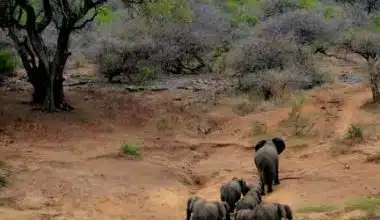The San people of Africa reside in the heart of the Kalahari Desert. These indigenous people of southern Africa initially lived primarily as hunters and gatherers.
Some people would find this description to be a futuristic utopia. But this passage from a Times article from 1969 alludes to the Kalahari hunter-gatherers. Some call them San. Some refer to them as Bushmen.
San People of Africa
The San are the earliest residents of Southern Africa, where they have lived for at least 20,000 years. The name San is generally used to designate a varied group of hunter-gatherers residing in Southern Africa who have historical and linguistic connections.
The San were also known as Bushmen, but this title has since been abandoned as it is considered pejorative. There are several diverse San groups; they have no collective name for themselves, and the labels ‘Bushman’, ‘San’, and ‘Basarwa’ (in Botswana) are used. The word “bushman” originated from the Dutch word “bossman,” which denoted an outlaw or bandit.
This term was given to the San during their protracted war against the colonists. The San regarded this as a proud and appreciated reference to their courageous fight for freedom from oppression and colonization. Many now accept the titles Bushmen or San. Like the earliest people to inhabit other areas of the world, the San have an awful history of poverty, social rejection, deterioration of cultural identity, and the violation of their rights as a community. Yet, the San have also gained the attention of anthropologists and the media with their survival and hunting abilities, wealth of indigenous knowledge of the flora and fauna of Southern Africa, and their rich cultural traditions.
San people speak many dialects of a set of languages renowned for the unique ‘clicks’ that may be heard in their speech, represented in writing by symbols such as! or /. Made up of tiny nomadic groups, San communities consist of roughly 25 men, women, and children. Groups get together during specific seasons of the year for social gatherings, gift-giving, and the sharing of news and information.
The San have no formal authority figure or leader but govern themselves by collective consensus. Long talks are used to resolve disputes, allowing each party to voice their concerns and work toward a consensus.
Some people can become leaders in niches where they are particularly good, like hunting or healing ceremonies, but they can’t rise to positions of widespread influence or authority. The white colonists found this highly puzzling when they tried to create treaties with the San. Leadership among the San is kept for people who have lived within that community for a long period and who have acquired a respectable age and good character. San is largely egalitarian, sharing such items as meat and tobacco.
A group typically owns and inherits land rights bilaterally. Political models are fundamentally based on kinship ties. Residency determines a group’s membership. An individual remains a member of his group as long as he resides on group land. Hunting is permitted on non-group land, but authorization from the owners is required.
San Hunting Methods
With their diverse range of hunting techniques, the African San are skilled hunters. Just two examples of mammals, birds, reptiles, and insects that are deemed hunting game are antelopes and giraffes. The hunt is a physically taxing task that can last anything from a few hours to many days, depending on the species being tracked.
#1. Trapping
When setting traps, the San use, among other things, pitfall traps or snares. They dig a hole and cover it with branches to set up a pitfall trap, perhaps at a waterhole where the prey frequently congregates. The enormous, deep hole in the trap makes it impossible for any animal to escape, making it easy prey.
The purpose of snare traps is to capture smaller animals, such as hares. Using plant fibers, a lethal snare is created for this trapping technique, which tightens as an animal enters the trap.
#2. Poisonous Bow and Arrow
The San often go hunting with a bow and arrow. But frequently, bows and arrows are insufficient to bring down the beast. The arrow becomes a lethal weapon only when combined with poison. The San utilizes a unique species of insect to poison their arrows. This toxin is capable of killing the prey. It does, however, also have the benefit of not contaminating every piece of meat.
#3. Endurance hunt
The first type of hunting that humans engaged in was endurance hunting, which involved pursuing prey until they eventually passed out. An upright gait on two legs and sweat pores that are cool provide humans with a major endurance advantage. However, lions and other predators rely on capturing their prey in one session. If not, they would become too hot, and the target would get away. The San are sophisticated trackers that know the animal and habitat very well, which helps them guide their way on a persistent hunt.
#4. San Rock Art
The indigenous San groups of southern Africa were originally hunting and gathering peoples. One of the greatest testaments to San history is the rock art seen throughout the subcontinent.
The earliest rock art in southern Africa is roughly 30,000 years old and is found on painted stone slabs from the Apollo 11 rock shelter in Namibia. Where our study took place—the Maloti-Drakensberg mountain massif of South Africa and Lesotho—rock paintings were done around 3,000 years ago, well until the 1800s.
For many years, people believed that any interpretation of the meaning of the artwork was valid. However, this neglected the San themselves.
We can expand our comprehension if we try to view rock art in light of San’s shamanistic ideas and experiences. Researchers studying rock art benefit from advancements in ethnography, or literature written by anthropologists who work with the San people.
San Belief System
The San religious system generally observes the supremacy of one mighty god while at the same time recognizing the presence of lesser gods along with their wives and offspring. The souls of the departed are also honored. Some San believe that cultivating the soil is in opposition to the divinely established order of the universe.
Some societies also venerate the moon. The most important spiritual entity to the southern San was Kaggen, the trickster deity. He created many things and appears in several mythologies where he might be silly or intelligent, tedious or helpful.
The word ‘/Kaggen’ can be interpreted as mantis”; this led to the assumption that the San worshipped the praying mantis. However, Kaggen is not always a praying mantis, as the mantis is simply one of his incarnations. He can also turn into an eland, a hare, a snake, or a vulture; he can adopt various shapes. When he is not in one of his animal forms, Kaggen lives his life as an average San.
San Rituals
A ritual is held when the boy is informed how to trace an eland and how the eland will fall if shot with an arrow. The boy will become an adult when he kills his first huge antelope, preferably an eland. Once trapped, the eland is skinned, and the fat from the animal’s throat and collarbone is cooked into a stew. In the girls’ puberty rites, a young girl is sequestered in her hut at her first menstruation. The ladies of the tribe execute the Eland Bull Dance, where they replicate the mating behavior of the Eland cows.
A guy will perform the part of the eland bull, generally with horns on his head. This ceremony will keep the girl lovely, free from hunger and thirst, and peaceful. As part of the marriage custom, the man presents the fat from the Elands’ heart to the girls’ parents. At a later time, the girl is anointed with Eland fat. In the trance dance, the Eland is considered the most potent of all creatures, and the shamans desire to possess the Eland’s potency.
The San believed that the eland was Kaggen’s favored animal. San people have rich oral traditions, and many of their tales include stories about the gods that serve to instruct listeners about what is considered moral San behavior.
San Dance and Music
The San, also known as Bushmen, are passionate about art, especially music, singing, and dancing. However, over the ages, their more advanced and distinctive art forms—painting and engraving—have been entirely abandoned.
Dancing is considered a kind of prayer to the gods and the spirits of ancestors and is therefore very sacred and magical to the San people.
The most significant of all San dances is the Dance Trance, also known as the healing dance; it can go on for several hours, if not the entire night, and is used to ward off illnesses brought on by evil spirits.
The village lights a large fire, and men dance around it while wearing anklets made of cocoons that make rhythmic noises with every step. Drums and flutes made of cane or bone accompany the dance. Women and children sit around the fire, sing, and beat their hands to the music.
Men are dancing in front of the fire; the beat and movement get progressively faster; they kick the ground with their feet; and some of them go into trances where they interact with the spiritual realm.
San Life in the Present
The San are still perceived as “primitive” and as needing to be forced to adopt a lifestyle similar to that of the bulk of cattle-herding tribes. The issues they face differ depending on where they reside. For instance, the majority of the Khomani tribe’s land rights are now recognized in South Africa, but many other San groups have no land rights at all. The majority of modern San are living at the very bottom of the social scale, in deplorable conditions of poverty that lead to drunkenness, violence, prostitution, disease, and despair. Very few can continue living as hunter-gatherers.
As recently as April 2002, the Botswana government forcibly removed the last remaining hunter-gatherers from the Central Kalahari Game Reserve to create room for diamond mines. To assist the San in reclaiming their land, a legal case is presently pending.
The stated purpose was to integrate them into contemporary culture and offer them facilities like schools and healthcare. In actuality, not many of these amenities have been provided, and the San are stuck in desolate camps in an unfriendly environment. The San people are amiable, imaginative, and peaceful. They have coexisted peacefully with their natural surroundings for at least 20,000 years and have never created any weapons of mass destruction. When appropriately returned to their native territories and reincorporated within southern Africa’s game reserves, San communities have the potential to become self-sufficient.
Who are the Khoe San people of Africa?
Indigenous people of Southern Africa, specifically in the countries of South Africa, Namibia, Botswana, and Angola, go by the name Khoe San, also spelled Khoisan. They have a rich cultural and genetic heritage, and people frequently recognize them by their distinctive linguistic click sounds.
How Many People Speak San in Africa?
About 50 self-identifying tribes make up the 130,000 or more San people who live in eight countries (Angola, Botswana, Eswatini, Lesotho, Namibia, South Africa, Zambia, and Zimbabwe). Many of these people speak Sanskrit as their native tongue.
What Type of Life Did the San Live?
The San people were the first hunter-gatherers in southern Africa. Their primary means of subsistence were harvesting herbs and hunting antelope-like gemsbok. To subsist, hunter-gatherer societies would fish, gather wild herbs, and hunt. They also lead a nomadic lifestyle, traveling from place to place.
Where in Africa Are San People From?
The hunter-gatherer San are believed to be derived from the first people to live in what is now South Africa and Botswana. They are among the oldest tribes on Earth.
What Language Did the San Speak?
The Khoekhoe, Khoemana, Shua, Tsoa, Ts’ixa, Kxoe, Naro, Haba, G’ana, Amkoe, and Tuu language families comprise the group of languages that the San people speak collectively.
Summary
Native people from southern Africa make up the San people. Native hunters and gatherers, the San people are the final surviving members of the oldest genetic group to arrive in southern Africa. Due to their distinct genetic markers and the discovery of 20,000-year-old archeological evidence of their nomadic hunter-gatherer society, genetic and historical evidence points to the San people as the oldest population on Earth.
- AFRICAN SAFARI TRIPS: Unforgettable Encounters in the Heart of Africa
- BEST PLACES TO VISIT IN AFRICA: Exploring the Continent’s Less Traveled Treasures
- SOUTH AFRICA HOLIDAYS: A Land of Breathtaking Landscapes and Diverse Cultures
- THE ULTIMATE LIST OF THE AFRICAN ISLAND COUNTRIES






